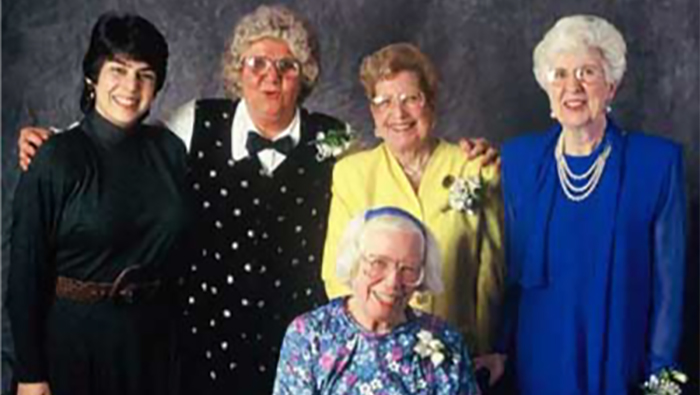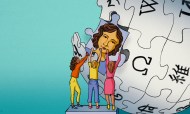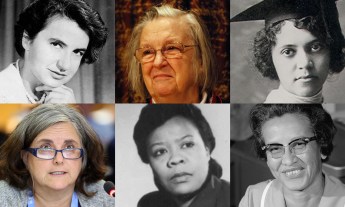
It seems like a story made for the movies: the first general-purpose computer was actually programmed by a half-dozen female math whizzes. Yet for too long, their efforts have been largely unknown. Lawyer and digital-rights advocate Kathy Kleiman describes her quest to learn about them and bring them some overdue recognition.
When I was a college student in the mid-1980s, I discovered something important about myself: I loved to program and I loved programming projects. But there was one problem. As I continued taking computer-science courses, I noticed that the number of women dropped dramatically. By the time I reached the advanced classes, there were just one or two women in the classroom — including me. I wondered, Did women belong in computing? Did we have any role models?
I knew, of course, about Lady Ada Lovelace and Captain (later Rear Admiral) Grace Hopper of the US Navy. But Ada Lovelace was in the 19th century, and Grace Hopper was in the 20th century. One woman succeeding per century didn’t make me feel warm and fuzzy about a future in computing.
I started scouring the histories and encyclopedias of computer science to find other women, and I didn’t find any. That is, until I came across an archival photograph of the ENIAC computer. The great ENIAC was a secret US Army project during World War II. It was the world’s first, all-electronic, programmable general-purpose computer and the great-great-grandfather of everything on our smartphones and in our laptops. In a photo of ENIAC from 1946, taken about six months after it was unveiled, I saw men and women. However, only the men’s names were listed in the captions. I dug deeper and found more photos of women in front of ENIAC. I brought the pictures to my professor and asked, “Who are these women?” He didn’t know, and he sent me to the cofounder of the Computer History Museum that was across the river in Boston.
The cofounder of the Computer History Museum told me that the women were models, posed in front of the machine to make it look good.
Clutching the photographs, I went there and showed them to the museum’s cofounder. I’ll never forget her response. She rolled her eyes and said, “They’re models.” She told me the women were posed in front of the machine to make it look good. But they didn’t look like models to me — they looked very confident and self-assured in front of the machine. The ENIAC was eight feet tall and 80 feet long, and it dominated three sides of a large room. I had worked with some big computers, and I knew how overwhelming they are the first few times you used them. The women in the photos looked like they knew exactly what they were doing.
To find out more, I started calling people at the University of Pennsylvania, which is where the ENIAC had been built during the war. One thing led to another, and I was invited to come to the 40th anniversary of ENIAC in 1986. That’s how I ended up in a room in Philadelphia celebrating the anniversary of the world’s first modern computer. It was very exciting, and there were clusters of men talking about how they had built ENIAC. I walked around, and I found a cluster of women. As I listened closely to them, they were talking about a bug in the program they had found the night before ENIAC’s first big demonstration. Suddenly I realized I was talking to the women in the pictures. They weren’t models; they were ENIAC’s first programmers!
There were no programming languages, no manuals, no compilers and no operating systems, so the women had to figure out how to program this massive machine on their own.
That day, I learned that ENIAC was programmed by six young women, who had been brought in specifically to write ENIAC’s first program for the Army: a ballistics trajectory. I met four of them at the celebration: Frances “Betty” Snyder Holberton, Jean Jennings Bartik, Kathleen “Kay” McNulty Mauchly Antonelli, and Marlyn Wescoff Meltzer. They told me about the two other women who were part of their project but not at the anniversary: Ruth Lichterman Teitelbaum and Frances Bilas Spence. (The women in the vintage photograph are Jean Bartik and Frances Spence.)
They were funny, dynamic women. In their 60s at the time of the anniversary, they told me they’d been recruited by the Army during WWII for their mathematics abilities. They’d all been brought to Philadelphia to hand-calculate ballistics trajectories — the path that a missile takes from the time it leaves the muzzle of an artillery gun until it hits its target eight to ten miles away. Calculated using differential calculus equations, it took them about 40 hours to do by hand. Because the men with these kinds of skills were involved in other war efforts, the military hired between 80 and 100 women to hand-calculate ballistics trajectories, and they called them “Computers.” Yes, a Computer was a person before it was a machine — that was actually their official title.
During the war, the military realized it needed more and faster trajectory calculations. So it commissioned a highly experimental project: building the Electronic Numerical Integrator And Computer, or ENIAC. ENIAC was designed to automate the ballistics equations, although few in the Army thought it would work. After it was built, the Army assigned six human Computers — that is, the six women — to the task of programming ENIAC. Of course, there were no programming languages, no manuals, no compilers and no operating systems, so the women had to figure out how to program this massive machine on their own. That was the story I learned at the 40th anniversary of ENIAC.
Excited, I returned to school and finished my computer science courses. I started my own career in technology, but ten years later, a bell went off in my head. I realized the 50th anniversary of ENIAC was coming up, and I wanted to know what happened to the ENIAC programmers. I called the University of Pennsylvania and found the dean who was responsible for the event. When I asked who among the ENIAC programmers would be attending, he didn’t know who I was talking about. He knew only the names of the women who were widows of the engineers. Otherwise, their names and roles had been forgotten.
The women had to track each piece of data, wire it into one of dozens of panels, such as a multiplier or square rooter, and then move the result by wire to another panel for storage.
I was determined to not let that happen to these amazing women. I applied for and received a grant to study the women of ENIAC. I planned to track them down, reintroduce myself, ask them about programming ENIAC, and record our interviews. I realized there was a chance that they might not remember the work because it had been done 50 years ago. I also worried that I’d ask the wrong questions. I knew modern programming and modern terminology, but what they did was different, even though they were performing the same basic functions of breaking down a calculation into steps that a computer could handle. If I could learn more about the technology, I could ask better questions. By that point, I was an attorney at a telecommunications law firm. I took a leave of absence from my job and spent a few months at the Library of Congress learning about ENIAC, BINAC and UNIVAC — three early computers created by overlapping teams of engineers and programmers. UNIVAC, which was the first commercial computer, was synonymous for years with the word “computer” in the minds of the public.

Armed with my newfound knowledge, I went back to the programmers and asked detailed questions about ENIAC in their terms. The memories came flooding out. They told me how they’d been given wiring diagrams and logical diagrams of ENIAC, and they were asked to figure out how ENIAC’s dozens of panels worked. Then they not only had to break down their program into steps the computer could handle, but they had to wire that program into the machine. They had to track each piece of data, wire it into a panel, such as a multiplier or a “square rooter,” and then move the result (physically by wire) to another panel for storage. Flow chart technology didn’t exist, so the women created what they called “pedaling sheets” — enormous sheets of paper designed to keep track of each step of the program as well as where all the switches, cables and wires went. It was an amazing story.
Producer/director David Roland and I recorded the interviews on tape and realized we had found programming pioneers that no one had ever heard of before. We wondered: Would anybody care? To see, some of the children of the ENIAC programmers and I nominated the women for awards. Happily, they were soon recognized from coast to coast, including induction into the Hall of Fame of Women in Technology International. Betty Holberton and Jean Bartik, in different years, were honored as Computer Pioneers by the IEEE Computer Society. My favorite award ceremony took place in 2008 when Jean Bartik was inducted as a fellow of the Computer History Museum alongside Linus Torvalds, who created Linux, and Bob Metcalfe, who created Ethernet.
After the screening, women came up to me with tears streaming down their faces. They worked for companies like Microsoft, Google, Amazon, and the idea that women helped create computing and programming was so uplifting.
Working with producers John Palfreman and Kate McMahon, I edited the oral histories together into a documentary called The Computers. Again, my question was: Would anybody care about this 70-year-old story? We premiered our movie at the Seattle International Film Festival in 2014. After the screening and the producer Q&A, women came up to me with tears streaming down their faces. They worked for companies like Microsoft, Google, Amazon, and they told me that the ENIAC programmers’ story had moved them deeply. In their teams and meetings, they were often the only women, and the idea that women helped create computing and programming was so uplifting to them. We took the documentary around the world, and again, I wondered whether people in other countries would care? But no matter where we went, women were inspired by the film, and it seemed the challenges of women in computing were universal. Men liked it, too, and talked about showing it to their daughters to inspire them to STEM.
But this story doesn’t have a completely happy ending — yet. Despite the fact that we now know the ENIAC, BINAC and UNIVAC teams were exceedingly diverse, much of the computer history community continues to tell the same story they’ve told for 70 years: that a small group of white men invented computing. That’s not true. Yes, there were brilliant white engineers, but there were also brilliant African-American engineers, Chinese engineers, and, of course, women. As we work to encourage girls and boys to enter careers in STEM, shouldn’t we be telling them that the pioneers of STEM looked like them and came from a range of diverse backgrounds? Shouldn’t we be sharing the names and inspiring stories of these individuals and teams?
Please join me in sharing the story of the ENIAC programmers. Let’s help young women and young men who have an interest in computing know that these careers lie within their grasp — and that history clearly shows us the best teams were the most diverse. If we truly want to tap the full potential of technologies of the future, we will need everyone’s ingenuity and insight.
This piece was adapted from a talk given at TEDxBeaconStreet.












